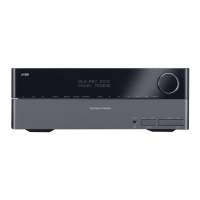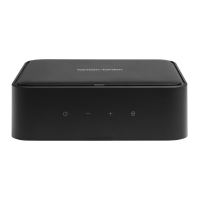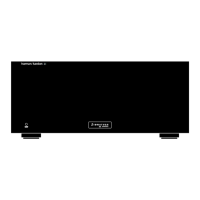Citation 7.0 Owner’s Manual
Preliminary Draft
Page # 51
Enitre Contents Copyright ©1995 - Harman Kardon Inc.
When the mute control is engaged, the word “Mute” will replace the volume level on the front panel display (figure
#xx), and it will flash at the bottom of the on screen display. This reminds you that the volume has been lowered.
To return to normal operation, either press the “Mute” button again, or touch any of the volume level controls.
Source Selection
Next to turning on the unit and controlling the volume, the most frequently used controls involve input source selection.
As you use the 7.0 you will want to change between the eight audio/video sources that may be connected to the 7.0’s
input switcher.
Input source selection is simple. Direct access to any source is available by pressing the numbered button in the
“Sources” box at the center of the remote control. (Figure #xx).
Input Sources may also be selected by scrolling through the eight inputs using the “ Source \/” and “Source /\” buttons
on the front panel. (Figure #xx).
After an input is selected, the on screen system will briefly display a message at the top of the screen. (Figure #xx)
Contained in the message will be the input number and the name assigned to that input either by the factory default
setting, or a user selected name that has been changed on the “Source Edit” menu.
The message will also display the surround mode that was last used, and it will switch to that mode.
Mode Selection
When the 7.0 is used for the first time, the surround mode that will be used with each input will be the one preset at the
factory. Consult the Factory Presets chart in Appendix #xx for a list of the sources and modes.
To change the mode in use, simply press any of the buttons on the remote within the “Surround Mode” outline.
Surround modes may also be selected by pressing the “Surround /\” and “Surround \/” buttons on the front panel.
When the mode is changed, selected, the on screen display will show the status line, with the input name and number
on the left and the new source mode on the right. (Figure #xx). Changing a mode will also attach the newly selected
mode to the input in use. The new mode then becomes the default for that input, and it will appear each time that
mode is selected in the future.
NOTE: When a mode is changed, the microprocessor system within the 7.0 will perform a series of complex
calculations and adjustments. In some cases, this may take a few seconds to complete, slightly delaying the time it
takes for the new mode to take effect. To remind you that this is taking place, a “****PROCESSING****” message may
appear briefly at the bottom of the on screen display and on the front panel.
In addition to the eight preset and four custom multichannel surround modes, the 7.0 may also deliver a traditional two
channel stereo signal with no signal processing, center channel or back channel feeds. To engage the bypass mode,
press “Stereo Only” on the remote.
As with any mode change, pressing “Stereo Only” will cause the status display to appear. Instead of a mode name,
“SURRND OFF” will appear at the right side of the both the on screen display and the two line display on the front
panel. As additional reminders, a “Surround Processing -- Off” message will also appear at the bottom of the on
screen display. (Figure #xx). The “Stereo” indicator will illuminate on the front panel, and any front panel indicators
relating to surround functions, such as center channel or filters will go out. Since the “Stereo Only” condition is a pure,
two channel mode, any of the 7.0’s processing is disengaged.
To return to the multichannel surround mode that was last used before pressing “Stereo Only”, simply press the button
again. Note that the front panel “Stereo” light will go out, and the center channel indicators will go on again, along with
any other appropriate front panel lights. A “Surround Processing -- On” message will appear at the bottom of the on
screen display, and the top line message will once again display the input and surround mode in use.

